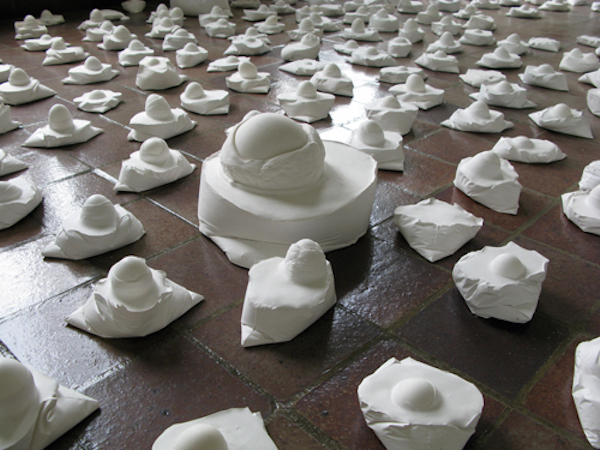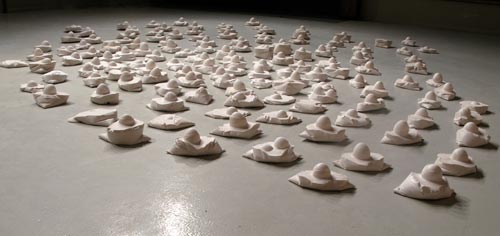Flash Nonfiction by Pamela Gay
A Meditation on Fragility and the Artistic Process

At a small gathering at the opening of a group show, the artist said this installation was inspired by her battle with breast cancer. “Eggshells came to mind,” she said.
The same year she was diagnosed, she was awarded a fellowship at an arts center in Nova Scotia. During her stay, the artist went to a nearby poultry farmer whom she’d befriended and asked if she could have some eggs, lots of eggs—she wanted to make something with them, she said to him, but not food, not breakfast or dessert.
She told us the farmer didn’t say her request was unusual or ask for more explanation. Nor did he smirk and make some kind of joke, like, Are you planning to egg someone’s house? Nor did he squint as if to say, What’s your problem? The farmer shifted his gaze to look into her eyes, and though he didn’t understand, he understood all he needed to know. “You can have all the discards,” he said to her, the eggs that were misshapen, discolored, blood-stained, defective.
Back in her studio, the artist washed a hundred eggs. She wanted to penetrate the shells in the way doctors would when performing a procedure on her. She punctured them, drained their contents, pulled in air with a large syringe.
She spoke quietly, even matter-of-factly, about her process. She told us this visceral experience helped her to handle the trauma of going through invasive medical procedures. “It was a way for me to get inside my body,” she said.
Next, she put the eggshells in separate Ziploc snack bags and poured plaster over them. When she removed them, she left the jagged pieces of plaster around the eggshells, “creating a hundred sculptural forms as you see here,” she said, turning her head to point to the installation spread out on a large gray-painted square in between four columns.
She told us this work was more personal than her other environmental installations. It was a way of healing after confronting death, she said, her blue eyes teary.
When her talk was finished and the crowd had dispersed, I walked over to the installation. Intrigued by the mystery I sensed under its sculptural forms—what looked to me like pieces of a puzzle, remnants of an iceberg more or less rising from some arctic landscape—I studied the way she’d chosen to cluster the stark white pieces. They were sporadically spread, yes, but not by accident.
I now saw that the jagged, plaster-encased shells evoked cancer spreading, metastasizing to the point when a human being becomes lifeless. It reminded me of the fragility of life—of all life forms—and my own eyes filled with tears.
Eggshells came to mind.

Editor’s Note: The artist who created this installation is Annie Varnot, who has given TW permission to include related images here. The group show referred to, "Element—Progress," was curated by artist John Ros and took place from April 9 to May 21, 2011, at Spool Mfg., Johnson City, New York. To learn more about the development of this project and to view photos, go to Annie Varnot’s website.
Art Information
- "W/hole 5" and "Egg Sack Installation" © Annie Varnot; used with permission.
 Pamela Gay teaches flash fiction and flash memoir at Binghamton University, State University of New York. Her writing has been published in Brevity, Iowa Review, Grey Sparrow, Midway Journal, Paterson Literary Review, Vestal Review, Phoebe, Other Voices, Monkeybicycle, Fringe, FragLit, Sleet, and other literary magazines as well as in two anthologies. She is the recipient of a New York Foundation for the Arts (NYFA) fellowship in creative nonfiction and a national e-book award for digital storytelling.
Pamela Gay teaches flash fiction and flash memoir at Binghamton University, State University of New York. Her writing has been published in Brevity, Iowa Review, Grey Sparrow, Midway Journal, Paterson Literary Review, Vestal Review, Phoebe, Other Voices, Monkeybicycle, Fringe, FragLit, Sleet, and other literary magazines as well as in two anthologies. She is the recipient of a New York Foundation for the Arts (NYFA) fellowship in creative nonfiction and a national e-book award for digital storytelling.
